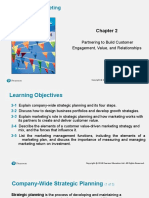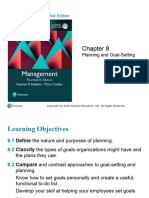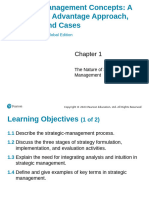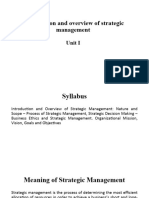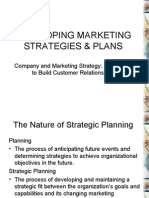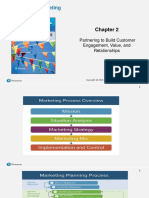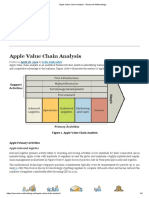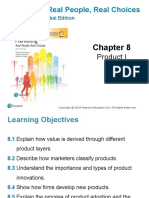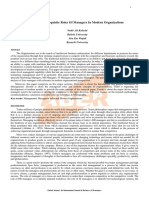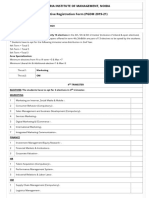0 ratings0% found this document useful (0 votes)
28 viewsMarketing: Real People, Real Choices: Ninth Edition, Global Edition
Marketing: Real People, Real Choices: Ninth Edition, Global Edition
Uploaded by
Jonathan LimMarketing
Copyright:
© All Rights Reserved
Available Formats
Download as PPTX, PDF, TXT or read online from Scribd
Marketing: Real People, Real Choices: Ninth Edition, Global Edition
Marketing: Real People, Real Choices: Ninth Edition, Global Edition
Uploaded by
Jonathan Lim0 ratings0% found this document useful (0 votes)
28 views36 pagesMarketing
Original Title
Topic 3 - Marketing
Copyright
© © All Rights Reserved
Available Formats
PPTX, PDF, TXT or read online from Scribd
Share this document
Did you find this document useful?
Is this content inappropriate?
Marketing
Copyright:
© All Rights Reserved
Available Formats
Download as PPTX, PDF, TXT or read online from Scribd
Download as pptx, pdf, or txt
0 ratings0% found this document useful (0 votes)
28 views36 pagesMarketing: Real People, Real Choices: Ninth Edition, Global Edition
Marketing: Real People, Real Choices: Ninth Edition, Global Edition
Uploaded by
Jonathan LimMarketing
Copyright:
© All Rights Reserved
Available Formats
Download as PPTX, PDF, TXT or read online from Scribd
Download as pptx, pdf, or txt
You are on page 1of 36
Marketing: Real People, Real Choices
Ninth Edition, Global Edition
Chapter 3
Strategic Market
Planning
Copyright © 2018 Pearson Education Ltd. All Rights Reserved.
Learning Objectives
3.1 Explain business planning and its three levels.
3.2 Describe the steps in strategic planning.
3.3 Describe the steps in market planning.
Copyright © 2018 Pearson Education Ltd. All Rights Reserved.
Planning: Compose the Big Picture
• Planning is everything … almost!
• Business planning is an ongoing process that
guides short- and long-term decisions.
Helps identify and build on firm strengths
Improves managerial decision making
Develops objectives and provides a means of
charting progress toward goals
Copyright © 2018 Pearson Education Ltd. All Rights Reserved.
Figure 3.1Three Levels of Business
Planning
Copyright © 2018 Pearson Education Ltd. All Rights Reserved.
Strategic Planning
• Strategic planning is the managerial process that
matches firms resources and capabilities to market
opportunities.
Top management defines firm’s purpose and sets
objectives.
Many large firms have separate SBUs (strategic
business units).
Copyright © 2018 Pearson Education Ltd. All Rights Reserved.
Strategic Business Units (SBUs)
• Large, multiproduct firms may have separate
divisions, called strategic business units (SBUs).
SBUs operate like a separate business.
• Strategic planning is conducted at both the
corporate and SBU level.
Copyright © 2018 Pearson Education Ltd. All Rights Reserved.
Functional Planning
• Functional – Planning done by top functional level
management
• Market planning includes:
Situation analysis
Broad 3– 5 year plan to support the strategic plan
Annual plan
Copyright © 2018 Pearson Education Ltd. All Rights Reserved.
Operational Planning (1 of 2)
• First-line managers focus on day-to-day execution
of functional plan.
• For marketers, this typically includes
Annual, semi-annual, or even quarterly action plans
to guide marketing plan implementation
Use of marketing metrics to monitor performance
Copyright © 2018 Pearson Education Ltd. All Rights Reserved.
All Business Planning is an
Integrated Activity
• Strategic, functional, and operational plans must be
in harmony for firm to succeed.
Planning at all levels flows from organizational
mission.
• Planners at all levels must keep the “big picture” in
mind.
Copyright © 2018 Pearson Education Ltd. All Rights Reserved.
Strategic Planning: Frame the
Picture
• Strategic planning plays an important role in the
modern corporation.
Optimize revenues across multiple lines of business.
Minimize risk in a complex and changing global
environment.
• Includes a series of steps that results in
development of growth strategies.
Copyright © 2018 Pearson Education Ltd. All Rights Reserved.
Figure 3.2 Steps in Strategic
Planning
Copyright © 2018 Pearson Education Ltd. All Rights Reserved.
Step 1: Define the Mission
• Key questions in determining mission
What business are we in?
What customers should we serve?
How should we develop the firm’s capabilities and
focus its efforts?
• A mission statement is a formal document that
describes the firm’s overall purpose and what it
hopes to achieve in terms of its customers,
products, and resources.
Copyright © 2018 Pearson Education Ltd. All Rights Reserved.
Mission Statements Are Important!
• Twitter’s mission statement is “To give everyone the
power to create and share ideas and information
instantly, without barriers.”
• The ideal mission statement is not too…
Broad
Narrow
Shortsighted
Copyright © 2018 Pearson Education Ltd. All Rights Reserved.
Step 2: Evaluate the Environment
• Examination of internal and external environments
• Managers often synthesize environmental analysis
of into a format known as SWOT analysis.
SWOT analysis catalogs firms’ internal strengths and
weaknesses and external opportunities and threats.
Copyright © 2018 Pearson Education Ltd. All Rights Reserved.
Internal Environment
• Internal environment
consists of controllable
elements within firm.
Key technologies
Patents
Financial stability
Supplier relationships
Reputation
Human capital
Copyright © 2018 Pearson Education Ltd. All Rights Reserved.
External Environment
• External environment consists of factors outside the
firm which that could positively or negatively impact
operations.
• Largely beyond direct management control, so
planning is critical
Economy
Competition
Technology trends
Sociocultural trends
Legal/political/ethical trends
Copyright © 2018 Pearson Education Ltd. All Rights Reserved.
SWOT Analysis
• Strengths
• Weaknesses
• Opportunities
• Threats
Copyright © 2018 Pearson Education Ltd. All Rights Reserved.
Step 3: Set Organizational or SBU
Objectives
• Organizational goals and objectives should be direct
outgrowth of the mission statement.
Taking into account internal and external
environmental factors
• Objectives should be specific, measureable,
attainable, and sustainable.
May be directed toward financial- , operational- , or
customer-based criteria
Copyright © 2018 Pearson Education Ltd. All Rights Reserved.
Step 4: Establish Business Portfolio
• A business portfolio represents the range of
different businesses that a large firm operates.
Disney operates multiple lines of business, including
movie studios, theme parks, cruises, etc.
• Portfolio analysis
Assesses the growth potential for a firms SBUs and
product lines
BCG Growth-Share Matrix
Copyright © 2018 Pearson Education Ltd. All Rights Reserved.
Figure 3.3 BCG Matrix
Source: Product Portfolio Matrix, © 1970, The Boston Consulting Group.
Copyright © 2018 Pearson Education Ltd. All Rights Reserved.
Step 5: Develop Growth Strategies
• Product-market growth matrix
Characterizes different types of growth strategies
based on market and product types.
Market penetration
Market development
Product development
Diversification
Copyright © 2018 Pearson Education Ltd. All Rights Reserved.
Figure 3.4 Product–Market Growth
Matrix
Copyright © 2018 Pearson Education Ltd. All Rights Reserved.
Strategic Planning Summary
• Successful executives understand strategic planning
as an ongoing process.
• One that proceeds from defining a shared purpose,
leading to business growth
1. Define the mission
2. Evaluate environment
3. Set objectives
4. Establish business portfolio
5. Develop growth strategies
Copyright © 2018 Pearson Education Ltd. All Rights Reserved.
Market Planning: Develop and
Execute Marketing Strategy
• Effective implementation of the four Ps requires a
great deal of planning.
• Steps are similar to those in strategic planning
Key difference relates to focus on issues relating to
marketing mix.
Copyright © 2018 Pearson Education Ltd. All Rights Reserved.
Figure 3.5 Steps in Market Planning
Copyright © 2018 Pearson Education Ltd. All Rights Reserved.
Step 1: Perform a Situation Analysis
• Analyze the marketing environment
• Conduct SWOT analysis
Copyright © 2018 Pearson Education Ltd. All Rights Reserved.
Step 2: Set Marketing Objectives
• Specific to the firm’s marketing mix-related elements
• Marketing objectives help achieve the overall
business objectives.
Copyright © 2018 Pearson Education Ltd. All Rights Reserved.
Step 3: Develop Marketing
Strategies
• Identify target market(s)
• Adjust marketing mix for
each target market
Product
Price
Promotion
Place (Distribution)
Copyright © 2018 Pearson Education Ltd. All Rights Reserved.
Step 4: Implement and Control the
Marketing Plan
• During implementation process, firms follow formal
process to determine progress toward marketing
objectives.
Measure actual performance
Compare performance to established objectives
Make adjustments to objectives or strategies based
on this analysis
Copyright © 2018 Pearson Education Ltd. All Rights Reserved.
Return on Marketing Investment
(ROMI)
• Return on marketing investment
Revenue (or profit) generated by investment in a
given marketing program divided by the cost of the
program at a given level of risk
For instance, if:
Revenue from Marketing Investment = $150,000
Cost of Marketing Program = $30,000
ROMI = 5.0
Copyright © 2018 Pearson Education Ltd. All Rights Reserved.
Action Plans
• Individual support plans included in a marketing plan
that provide guidance for implementation and control
of the various marketing strategies within the plan.
Sometimes referred to as marketing programs
Managers create actions plans for key elements
involved in implementing the marketing strategy.
Copyright © 2018 Pearson Education Ltd. All Rights Reserved.
Assigning Responsibility in the
Action Plan
• Who will be responsible for carrying out each part of
the marketing plan?
• Not everybody involved will be marketers
Sales
Production
Quality control
Shipping
Customer service
Finance
IT
Copyright © 2018 Pearson Education Ltd. All Rights Reserved.
Creating Action Plan Timelines
• Each action plan requires a time line needed to
accomplish the various tasks.
• Often portrayed in flowchart form to help managers
and employees visualize sequence of tasks
Gantt charts
PERT charts
Copyright © 2018 Pearson Education Ltd. All Rights Reserved.
Setting a Budget
• Each cost element of the action plan should link to a
budget item.
Increases accountability for all parties involved with
implementing the marketing plan
Accuracy in estimating individual action plan
expenditures helps overall marketing budget
forecasting.
Copyright © 2018 Pearson Education Ltd. All Rights Reserved.
Deciding on Measurements and
Controls
• Marketing control is a formal process for:
Measuring performance
Comparing performance to established marketing and
strategy objectives
Making adjustments to the objectives or strategies
based on this analysis
• Selecting the right metrics should account for short-
term objectives balanced against firm’s long-term
sustainability.
Copyright © 2018 Pearson Education Ltd. All Rights Reserved.
Operational Planning (2 of 2)
• Operational plans focus on day-to-day execution of
the marketing plan.
Cover a shorter period of time than strategic and
functional plans
Often falls to lower level managers
Include detailed instructions for activities, specifies
responsibilities, and provides time lines
Many key marketing metrics actually are used at the
operational level of planning.
Copyright © 2018 Pearson Education Ltd. All Rights Reserved.
You might also like
- Solomon rprc11 PPT 03 AccessibleDocument48 pagesSolomon rprc11 PPT 03 Accessiblertv4boxNo ratings yet
- Amazon Value Chain Analysis - Research-MethodologyDocument5 pagesAmazon Value Chain Analysis - Research-MethodologyJonathan LimNo ratings yet
- David Sm16 Ppt01 AccessibleDocument37 pagesDavid Sm16 Ppt01 Accessiblemagendren raman100% (1)
- CH 8 - Planning and Goal SettingDocument23 pagesCH 8 - Planning and Goal SettingMd. Murad Parvej 203-33-1342100% (1)
- Marketing: Real People, Real Choices: Welcome To The World of MarketingDocument42 pagesMarketing: Real People, Real Choices: Welcome To The World of MarketingJonathan Lim100% (1)
- Introduction To Management: Planning & Goal SettingDocument31 pagesIntroduction To Management: Planning & Goal SettingMaisarah NorzihanNo ratings yet
- The Concept of Strategy and The Rational Approach To Strategy DevelopmentDocument47 pagesThe Concept of Strategy and The Rational Approach To Strategy DevelopmentMuhammad Ahsan Rafique100% (5)
- Principles of Marketing: Partnering To Build CustomerDocument35 pagesPrinciples of Marketing: Partnering To Build CustomerNurul DiyanaNo ratings yet
- Kotler Pom17e PPT 02-UpdatedDocument20 pagesKotler Pom17e PPT 02-UpdatedMinh Quân Đặng Lê100% (1)
- Strategic Planning: Principles of MarketingDocument40 pagesStrategic Planning: Principles of MarketingSharill RezaNo ratings yet
- Chapter 2Document35 pagesChapter 2tranthithuhang23052004No ratings yet
- David Strategic Management 17e Accessible PowerPoint 01Document36 pagesDavid Strategic Management 17e Accessible PowerPoint 01Abdul AhmedNo ratings yet
- MKT 201 CH 2Document24 pagesMKT 201 CH 2Rida ChamiNo ratings yet
- Principles of Marketing: Seventeenth EditionDocument39 pagesPrinciples of Marketing: Seventeenth EditionAtang Wadi100% (1)
- Chapter 3 - Strategic Market Planning PDFDocument9 pagesChapter 3 - Strategic Market Planning PDFKarina Gabriella SanchezNo ratings yet
- PlanningDocument31 pagesPlanningMuneeb U RahmanNo ratings yet
- QTCL 1-7Document297 pagesQTCL 1-7Phương Nguyễn LamNo ratings yet
- Chapter 1Document32 pagesChapter 1Bảo QuốcNo ratings yet
- Chapter 8 - Planning and Goal SettingDocument31 pagesChapter 8 - Planning and Goal SettingMaram AbdullahNo ratings yet
- CH 3 HRDocument58 pagesCH 3 HRعبدالرحمنNo ratings yet
- CH 3. POMDocument31 pagesCH 3. POMProf. Maseera PatelNo ratings yet
- W1_01 The Nature of Strategic ManagementDocument33 pagesW1_01 The Nature of Strategic Managementhsknkpx8vkNo ratings yet
- ManagementDocument29 pagesManagementAqsa GulNo ratings yet
- week 3Document20 pagesweek 3yehiaahmed200003No ratings yet
- Unit I SMDocument65 pagesUnit I SMveeramangalaNo ratings yet
- David Strategic Management 17e Accessible PowerPoint 01Document33 pagesDavid Strategic Management 17e Accessible PowerPoint 01hamzeh hakeemNo ratings yet
- Chap 1 - PPTDocument33 pagesChap 1 - PPTkimoanhhvnh6868No ratings yet
- Lecture 8Document32 pagesLecture 8Tan Chee SengNo ratings yet
- SM Module-1Document109 pagesSM Module-1sudheesh ksNo ratings yet
- Unit 1Document12 pagesUnit 1kavyaNo ratings yet
- Ch02 Company and Marketing Strategy PartneringDocument72 pagesCh02 Company and Marketing Strategy PartneringAyan HuseynliNo ratings yet
- Basic Concepts of Strategic Management Part 1Document15 pagesBasic Concepts of Strategic Management Part 1Samantha Nicole GeliNo ratings yet
- Definition of Strategy: BM1807 Basic Concepts of Strategic Management (Part 1)Document4 pagesDefinition of Strategy: BM1807 Basic Concepts of Strategic Management (Part 1)ShinezxNo ratings yet
- Module 3 - Business StrategyDocument31 pagesModule 3 - Business StrategyAschalew AsnakeNo ratings yet
- Developing Marketing Strategies & Plans: Company and Marketing Strategy: Partnering To Build Customer RelationshipsDocument38 pagesDeveloping Marketing Strategies & Plans: Company and Marketing Strategy: Partnering To Build Customer RelationshipsMarisol DulceNo ratings yet
- Introduction To StrategyDocument12 pagesIntroduction To StrategydeewanzNo ratings yet
- Marketing Strategy Project FullDocument63 pagesMarketing Strategy Project FullAYYAPPAN1883% (46)
- The Nature of Strategic ManagementDocument27 pagesThe Nature of Strategic ManagementValeria MaldonadoNo ratings yet
- Kotler Poma4e Ch02Document25 pagesKotler Poma4e Ch02svqcsgd9ncNo ratings yet
- BF Note CA CL.Document19 pagesBF Note CA CL.iftekharNo ratings yet
- Chapter 12Document35 pagesChapter 12Hafsa IqbalNo ratings yet
- Business PolicyDocument15 pagesBusiness PolicyAnonymous v56GZxn100% (1)
- Ahrm Sem 5Document122 pagesAhrm Sem 5Vishva BhattNo ratings yet
- Assignment 1 - Marketing ManagementDocument9 pagesAssignment 1 - Marketing Managementwidi tigustiNo ratings yet
- Basic Concepts of Strategic ManagementDocument43 pagesBasic Concepts of Strategic ManagementFarah Farah Essam Abbas HamisaNo ratings yet
- CH 12Document38 pagesCH 12HIMANSHU AGRAWALNo ratings yet
- Chapter 1 Imperatives for Market-Driven StrategyDocument49 pagesChapter 1 Imperatives for Market-Driven Strategyali.waheed0082020No ratings yet
- Definition of StrategyDocument5 pagesDefinition of StrategyAmit JainNo ratings yet
- Marketing Plan LectureDocument79 pagesMarketing Plan LectureAaliyah Kassandra BulaonNo ratings yet
- Chapter 2 Startegic PlanningDocument79 pagesChapter 2 Startegic Planningamr hosnyNo ratings yet
- Note Ebscm - Strategic Management (Chapter 1)Document48 pagesNote Ebscm - Strategic Management (Chapter 1)Mohd FirdausNo ratings yet
- Strategic ManagementDocument29 pagesStrategic Managementkarmakarritesh100% (1)
- Corporate Strategy SummaryDocument75 pagesCorporate Strategy SummaryBenedetta NardizziNo ratings yet
- Module 1 Session 1 Fundamental Concepts of Strategic Business Analysis - Components of Business AnalysisDocument6 pagesModule 1 Session 1 Fundamental Concepts of Strategic Business Analysis - Components of Business AnalysisKeneth Parcia100% (1)
- CH 5 Planning Modified 2024Document30 pagesCH 5 Planning Modified 2024rimhizem86No ratings yet
- Chapter 7 Strategic ManagementDocument58 pagesChapter 7 Strategic ManagementMuhammad HarisNo ratings yet
- The SocietyDocument33 pagesThe SocietyJonrei NatividadNo ratings yet
- Strategic Analysis of Internal Environment of a Business OrganisationFrom EverandStrategic Analysis of Internal Environment of a Business OrganisationNo ratings yet
- Samsung Value Chain Analysis - Research-MethodologyDocument5 pagesSamsung Value Chain Analysis - Research-MethodologyJonathan LimNo ratings yet
- Apple Value Chain Analysis - Research-MethodologyDocument4 pagesApple Value Chain Analysis - Research-MethodologyJonathan LimNo ratings yet
- An E-Transformation Study Using The Technology - Organization - Environment FrameworkDocument12 pagesAn E-Transformation Study Using The Technology - Organization - Environment FrameworkJonathan LimNo ratings yet
- Topic 8 - MarketingDocument36 pagesTopic 8 - MarketingJonathan LimNo ratings yet
- Marketing: Real People, Real Choices: Segmentation, Target Marketing, and PositioningDocument31 pagesMarketing: Real People, Real Choices: Segmentation, Target Marketing, and PositioningJonathan LimNo ratings yet
- Mintberg RolesDocument150 pagesMintberg RolesJonathan LimNo ratings yet
- Crisis ManagementDocument55 pagesCrisis ManagementJonathan LimNo ratings yet
- Managing Decentralise OrganasationDocument53 pagesManaging Decentralise OrganasationJonathan LimNo ratings yet
- The Prime-Requisite Roles of Managers in Modern OrganizationsDocument6 pagesThe Prime-Requisite Roles of Managers in Modern OrganizationsJonathan LimNo ratings yet
- The Manager's - Ob: Folklore and FactDocument13 pagesThe Manager's - Ob: Folklore and FactJonathan LimNo ratings yet
- Business EthicDocument21 pagesBusiness EthicJonathan LimNo ratings yet
- Results Based LeadershipDocument10 pagesResults Based LeadershipJonathan LimNo ratings yet
- Marketing: Real People, Real Choices: Market ResearchDocument34 pagesMarketing: Real People, Real Choices: Market ResearchJonathan LimNo ratings yet
- Factors Impacting Leadership EffectivenessDocument5 pagesFactors Impacting Leadership EffectivenessJonathan LimNo ratings yet
- Marketing Management - Topic 6Document45 pagesMarketing Management - Topic 6Jonathan LimNo ratings yet
- Session 8 Learning & Development-RevisedDocument38 pagesSession 8 Learning & Development-RevisedJonathan LimNo ratings yet
- Financial Management Note 9Document28 pagesFinancial Management Note 9Jonathan LimNo ratings yet
- Capital Budgeting Project ReportDocument77 pagesCapital Budgeting Project ReportJonathan LimNo ratings yet
- Marketing: Real People, Real ChoicesDocument16 pagesMarketing: Real People, Real ChoicesJonathan LimNo ratings yet
- Documents Tips Pgbm01-Finance-Management PDFDocument25 pagesDocuments Tips Pgbm01-Finance-Management PDFJonathan LimNo ratings yet
- CryptoOutlook2024 - Bitcoin Suisse CompressedDocument70 pagesCryptoOutlook2024 - Bitcoin Suisse CompressedmarcellusdarrenNo ratings yet
- Chapter 6 MCDocument4 pagesChapter 6 MCapi-3749577No ratings yet
- Conceptualizing, Measuring, and Managing Customer Based Brand Equity (Keller)Document23 pagesConceptualizing, Measuring, and Managing Customer Based Brand Equity (Keller)Sayed Shaiq Ali MusaviNo ratings yet
- MEM Assignment-2Document6 pagesMEM Assignment-2Jyotirmaya MohapatraNo ratings yet
- Thom22e Ch01 FinalDocument26 pagesThom22e Ch01 FinalMuha DarsaNo ratings yet
- Iofe U2 A3 WRQDocument7 pagesIofe U2 A3 WRQapi-404111666No ratings yet
- Group 3 HI5004 Group Report 1 1Document9 pagesGroup 3 HI5004 Group Report 1 1Sunny KumarNo ratings yet
- Tomb Shares Price, TSHARE Chart, and Market CapDocument1 pageTomb Shares Price, TSHARE Chart, and Market CapMichael EngellennerNo ratings yet
- Análisis Del Caso Kodak InglesDocument9 pagesAnálisis Del Caso Kodak InglesIsabel ArenasNo ratings yet
- Understanding LiberalismDocument71 pagesUnderstanding Liberalismames100% (1)
- Pearson Economics 11 The Market Economy 2023Document299 pagesPearson Economics 11 The Market Economy 2023HiiiNo ratings yet
- Edited Presentation FINAL COPY - Whole FoodsDocument46 pagesEdited Presentation FINAL COPY - Whole FoodsShahriar AlamNo ratings yet
- Assignment 1 SolutionDocument10 pagesAssignment 1 SolutionJunaid AhmedNo ratings yet
- Kallis 2012 The Economics of DegrowthDocument9 pagesKallis 2012 The Economics of Degrowthluquitas84No ratings yet
- Chapter OneDocument66 pagesChapter OnealtasebwoldeNo ratings yet
- Essentials of Marketing Management Market Segmentation, Targeting and Positioning (STP) Analysis On Airtel Business Description of AirtelDocument4 pagesEssentials of Marketing Management Market Segmentation, Targeting and Positioning (STP) Analysis On Airtel Business Description of AirtelMANISH CHINTALANo ratings yet
- Achievable Series 7 Dump Sheet Cram Sheet Regulators Laws RulesDocument1 pageAchievable Series 7 Dump Sheet Cram Sheet Regulators Laws RulesSourav SharmaNo ratings yet
- Unit 4 - Sales Territory MGT - QuotaDocument47 pagesUnit 4 - Sales Territory MGT - Quotaakshansh.gehlot188No ratings yet
- Adventurous Trader ReportDocument7 pagesAdventurous Trader ReportKwang Wei Long100% (1)
- Jaipuria Institute of Management, Noida Elective Registration Form (PGDM 2019-21)Document4 pagesJaipuria Institute of Management, Noida Elective Registration Form (PGDM 2019-21)Ravina SinghNo ratings yet
- Byju The UnicornDocument1 pageByju The Unicornashwin moviesNo ratings yet
- Project For Ripening ChamberDocument26 pagesProject For Ripening ChamberSmriti KhannaNo ratings yet
- Biscuit Industry in India-1Document15 pagesBiscuit Industry in India-1Priya BabuNo ratings yet
- Types of SharesDocument2 pagesTypes of SharesCelina NowakNo ratings yet
- Session 6 Branding Decisions StudentsDocument32 pagesSession 6 Branding Decisions StudentsAsmita KandariNo ratings yet
- Cash Flow Analysis, Target Cost, Variable Cost PDFDocument29 pagesCash Flow Analysis, Target Cost, Variable Cost PDFitsmenatoyNo ratings yet
- Terraport v2 WhitepaperDocument21 pagesTerraport v2 Whitepaperkishan panchalNo ratings yet
- Introduction To RetailingDocument10 pagesIntroduction To RetailingMahesh ArumugamNo ratings yet
- Principles of Marketing AssignmentDocument10 pagesPrinciples of Marketing AssignmentRahat RahmanNo ratings yet
- VCBHJNDocument96 pagesVCBHJNMihiri MadushaniNo ratings yet









